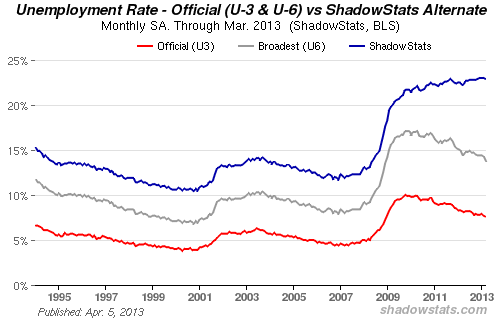Which is still only the U-6 unemployment rate!
An even more realistic unemployment rate is:
The seasonally-adjusted SGS Alternate Unemployment Rate reflects current unemployment reporting methodology adjusted for SGS-estimated long-term discouraged workers, who were defined out of official existence in 1994. That estimate is added to the BLS estimate of U-6 unemployment, which includes short-term discouraged workers.
The U-3 unemployment rate is the monthly headline number. The U-6 unemployment rate is the Bureau of Labor Statistics’ (BLS) broadest unemployment measure, including short-term discouraged and other marginally-attached workers as well as those forced to work part-time because they cannot find full-time employment.
And that brings us to a real unemployment rate of about 23%:

Source: Alternate Unemployment Charts (Shadow Government Statistics)
– Unemployment Is Really 14.3%–Not 7.6% (Forbes, April 8, 2013):
The current job-creation numbers are meaningfully below the level we might expect during a period of record corporate earnings and the reaching of new peaks in the major stock market indices.
Let’s go to the videotape –
The unemployment rate is 7.7%. But, there is another 0.6% of discouraged workers,(about 800,000) mainly the young, minorities and those without the all-necessary high school diploma. Another 0.9% are only marginally employed (whatever that means) and have mostly stopped looking for a job recently. More crushing is the 5.1% of the workforce most impacted by the 2008 downturn, who are working only part-time and would prefer to have a full-time position. That 5.1% part-time workers total 8 million people, who mostly are having trouble making ends meet and most likely have no health plan from their employer, according to Bob Eisenbreis, vice chairman and chief monetary economist at Cumberland Advisers, a New York-based investment firm that makes useful comments on the economy.
These numbers added together suggest that the true unemployment level– when part-time workers are included– is 14.3%–meaning that one in seven of every potential full-time employee in the U.S. economy is not able to earn a proper living wage–and thereby contribute to the snails-pace of economic growth.To my way of thinking the dropout rate is the most perplexing, because how do these people survive? Moreover, the percentage of people employed is only 58.5%, down from 61%, the level hit in 2008 when Obama was first elected–and to be fair before the meltdown on Wall Street. And the jump in first-time unemployment claims last week was the highest level since last November.
Now comes the sequester–which is meant to slice 1.75% from GDP at a time the economy is supposed to be growing at only a 1.6% pace at best. In other words, fewer people will be earning wages just as bullish sentiment is gaining momentum for a risk-on long position in equities. Everywhere I go seasoned veterans believe the market’s current valuation of about 14 times earnings makes them comfortable for a long-lasting bull market. Because, after all, they argue–there is far more risk in the bond market. Incredibly, perversely almost–the public’s accumulation of fixed income mutual funds and ETFs continues big time.
I can only conclude that maybe corporate earnings will continue to increase, rewarding equity investors, because of the high unemployment rate.